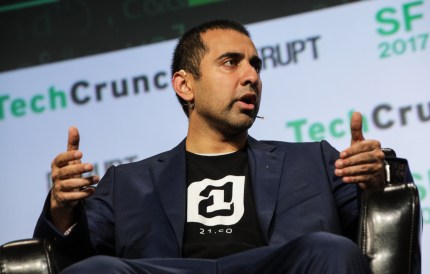Sanjay Manchanda
Challenging times for the tech and consumer industries have created a lot of buzz around “subscription fatigue.” The very model that business and consumer platforms have relied on for growth and predictable revenue seems under threat in a changing economy.
There is one problem with that idea, however: It is not true. Subscriptions are not dying; they are just evolving.
Smart companies are iterating on the subscription model with variations such as usage-based billing. Here’s what we have learned from supporting more than 4,500 subscription businesses with subscription billing and revenue management as they respond to changing times.
A short history of subscriptions
Today’s generation of subscription models has had a strong run since the rise of Salesforce in the mid-2000s and shifts by major companies like Adobe and Microsoft normalized them in B2B.
In B2C, company after company aspired to replicate the success of Netflix. A long-tested model that sounded like a relic of the world of newspapers and “book of the month” clubs going back to the 1600s became the hottest trend in tech and e-commerce. And, digital infrastructure has provided a wide range of opportunities to innovate.
But in 2022, the conversation has shifted. When Netflix reported that it had lost 200,000 subscribers in Q1 2022 and expected to lose 2 million more in the months ahead, a new narrative was born in both B2B and B2C. Many industry commentators saw it as a signal of a much more profound shift, where customers were paring back spending and abandoning subscriptions as a category.
What’s really happening
The facts tell a very different story, though. Netflix’s Q2 reporting included a loss of 1 million subscribers. Its results suggest that “subscription fatigue” is not what it appears to be. Moreover, new businesses are still building themselves entirely around subscriptions and traditional businesses are still adopting subscription offerings at a stunning rate.
However, these businesses now must be more strategic about how they set themselves apart. That is the more realistic explanation of what has happened with Netflix. At one time, Netflix was essentially the only option. Today, Disney, Hulu, Paramount and many others give consumers a wide range of options for content and other service features.
Overall, subscriptions to streaming services rose to 1.3 billion worldwide in 2021. That growth is good news for subscription video in general, but competition makes customer acquisition and retention more challenging.
Enter usage-based billing
Usage-based billing (popularly called “consumption-based pricing”) puts a different spin on subscriptions, one that is well suited to meet a different economic climate of thrifty habits. According to our data, there has been a 30% increase in startup merchants who offer usage-based plans.
Usage-based billing is becoming more prevalent — penetration is expected to be 56% among SaaS companies in 2023. In fact, a Bain & Company survey indicated 75% of companies intend to expand their usage-based offerings. And just like with the earlier wave of subscriptions, a few standout companies are showing the model’s power, such as Snowflake, JFrog, Amazon Web Services and Twilio.
At the same time, one factor that held back usage-based billing is changing quickly. Building or adopting usage-based elements requires the ability to break a service down into measurable units. It also requires a right tech stack to support the model throughout a company’s operations — from product development and marketing and sales to customer support and accounting.
Many platforms are sprouting up to help businesses pursue this model. In the past 12 months, approximately $100 million has been invested in seed and Series A equity investments backing a set of “pure-play” usage-based billing and rating engines. These companies are giving customers new mechanisms for monitoring the usage of different types of services, including software.
How to capitalize on the usage-based billing trend
Although more enabling technologies have become available, usage-based billing requires many new ways of thinking for a company in relation to strategy, marketing, product development and back-office operations. However, we are seeing some common patterns that help companies succeed.
Hybrid approaches
It is often unrealistic to shift to a pure usage-based approach, especially for businesses with other pricing models. Research shows only 27% of companies employ it alone, while 46% offer all pricing elements, including once-off purchases, fixed-price subscriptions and usage-based billing.
Put strategy and planning first
Usage-based models take careful thought.
What exactly is the most meaningful unit that you can measure? It could be API calls, system resources, minutes or items, but it has to meet two critical criteria:
- It has to be something that customers value and understand. For example, pricing a consumer product using highly technical units would create confusion.
- It has to be something that you can meter, capturing what has been used and when. That has implications for your entire architecture. It’s essential to research your customers and audit your tech stack.
Consider the back office
Fixed-price subscriptions make billing, accounting and forecasting relatively simple. Multiplying the number of monthly subscribers by the subscription price gives you the monthly recurring revenue (MRR) for a product.
In a usage-based model, you cannot forecast MRR as easily or as confidently. You should bring your CFO and customer support teams into the process to figure out important questions such as revenue recognition and forecasting on the finance side, and cancellations, rebates and refunds on the customer support side.
Rethink your marketing and communication strategy
Adding a new usage-based option or migrating existing subscribers to one needs to be handled carefully. It takes a compelling message and a clear story to convince customers why it makes sense. After all, you should not frustrate them with options or bills they do not understand. The wrong message can make it seem like you are just finding a clever way to raise prices.
Respect your customers
With older mobile telephone plans, usage-based pricing was notorious for making people choose between restricting their usage or spending more on extra minutes. SaaS companies should adopt the best parts of that model without creating new challenges for customers, such as unpredictable billing and runaway costs at peak usage times.
Most companies expect predictability in their operating expenses even while only paying for what they use.
The takeaway for existing subscription models
If you already offer a subscription-based model and are seeing subscribers drop off, making assumptions about why they’re doing so is a recipe for failure.
Instead, think about what you can do to make it a graceful departure while learning as much as possible. While you cannot stop exits, you can influence how they happen. Often, price is not the reason for departure. While pricing is important, your subscriber’s relationship with your business is a function of “perceived value.”
You can try to stop churn as it happens by offering alternatives, such as temporary pauses, different incentives or alternative pricing models that might better fit their needs. And if you avoid coercive tactics such as forcing customers to jump through hoops to cancel, they will be more willing to give you honest feedback on what triggered their decision if they still decide to leave. That valuable data will help you figure out whether adding or evolving to usage-based options makes sense.
Starting fresh
If you do not yet offer subscriptions, the buzz around “subscription fatigue” should not scare you off. It still remains a viable and popular model. Even companies in unlikely industries, such as Taco Bell and Panera Bread, are still launching subscriptions. People can subscribe to everything from noodles and pickles to socks and cacti.
In other words, there is a lot of room to innovate. Starting with a subscription offer also gives you an advantage over more established subscription businesses, as you can make sure your entire tech stack supports new models beyond fixed pricing and avoid making costly migrations later on.
In a nutshell
Subscriptions are not going anywhere. They have been around since at least the 17th century for a good reason — people like them. And the technology to improve upon them is only getting more sophisticated and flexible. So as you look ahead to potentially turbulent times in the global economy, this time-tested option will likely serve you well.































Comment